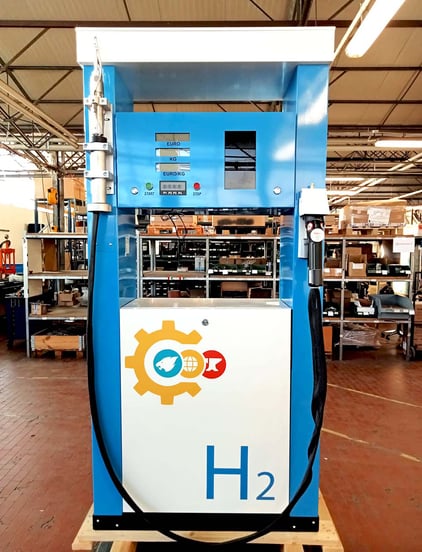An integral part of the energy transition in the field of fuels will soon involve hydrogen technology. The most impacted market will be road transportation, ranging from vans to articulated vehicles, with the goal of significantly reducing emissions. In this context, we have developed a pilot project for a hydrogen dispenser for one of the leading Italian manufacturers of refueling systems.
The Client
Cedem is a company based in Modena that produces turnkey refueling systems, managing all phases of the facility's realization from design and construction to maintenance and spare parts. They handle the construction of dispensers for various fuels, including gasoline, diesel, LPG, and methane.
Today, Cedem is among the first manufacturers capable of providing services and solutions for new hydrogen technologies, such as dispensers, safety valves, and customized testing services. The company approached Interfluid to combine our expertise in this sector and design a hydrogen refueling station.
Objective: A New Sealing Technology
The company sought our technical support to convert a methane refueling station into a hydrogen refueling station. The transition from one gas to another is not straightforward, as it requires a change in sealing technology. While the intrinsic danger of the two gases is similar, the molecule's shape and size differ significantly (given that hydrogen has the smallest molecule size).
The client was aware of the need to replace the sealing technology and had already identified the most suitable one for the hydrogen objective within the hydrogen sector. They turned to Interfluid to find technicians with experience in managing hydrogen at those pressures. Our key role was to verify that the chosen technology was optimal not only for performance but also for cost and safety.
 The Solution: Technical Support and Training for the New Hydrogen Dispenser
The Solution: Technical Support and Training for the New Hydrogen Dispenser
The work plan for the refueling station was initiated at the end of 2021 and engaged us for about two years with various tasks: from supplying components to technical support, to training personnel for the different sealing technology.
For the technical project, we adopted the historical high-pressure technology (C+T, Cone and Thread) defined by Hydrogen Europe guidelines to transform the existing system and bring it to much higher pressures and a different gas (specifically, from methane to hydrogen).
Alongside Cedem's technicians, we selected the most suitable components from our suppliers' catalogs, specifically choosing:
- Nova Swiss for valves, safety valves, and solenoid valves;
- PHP for fittings and connectors;
- Premier Industries for pressure regulators.
We also provided the pneumatic components for the operation of actuated valves and pilot-operated regulators. Subsequently, the client's technicians handled sizing and electronic integration.
The opportunity to obtain a complete package of components (fittings, valves, safety valves) from a single supplier was particularly appreciated. Additionally, our strong partnerships with suppliers allowed us to access unique training opportunities. In this case, we were able to invite Cedem's technicians to a training course at Nova Swiss to provide them with skills in the implementation and assembly of C+T technology.
Training technicians during the design phase enables them to acquire all the necessary knowledge to manage new facilities and technologies. This can be accomplished through our partners' training courses, at our headquarters, or at our clients' locations. Upon completion, we issue certificates valid for both the specific product under the project and all interchangeable products.
Results and Next Steps
After two years of work, the pilot project has concluded successfully. The installation was successful, and Cedem presented the new refueling station at one of the major exhibitions dedicated to refueling system manufacturers.
The new dispenser is a prototype, and data and measurements need to be collected to assess its performance. We expect meaningful numbers within a year. In the meantime, hydrogen refueling technology is rapidly expanding. In Italy, including this project, only three refueling stations are present, and new projects will need to be developed to provide sufficient infrastructure to support the energy transition to hydrogen fuels.




 The Solution: Technical Support and Training for the New Hydrogen Dispenser
The Solution: Technical Support and Training for the New Hydrogen Dispenser
